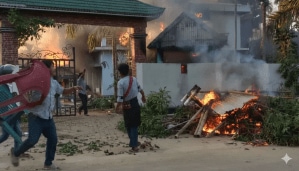Blast and after: The fiery red and yellow of Thailand’s curry politics
At 7 pm on Monday, a bomb went off at the Erawan shrine in central Bangkok, killing at least 18 and leaving more than a hundred injured.
 A cellphone photograph taken minutes after Monday’s blast.
A cellphone photograph taken minutes after Monday’s blast.
What is the political unrest in Thailand about?
Since February 2001, when Thaksin Shinawatra took over as prime minister, Thailand’s political struggle has largely centred around him. The business tycoon-turned-politician was hugely popular among farmers and the working class because of his populist policies, but was bitterly opposed by the royal family, the military and the Bangkok-based elite. In September 2006, he was ousted in a military coup and has been living in self-imposed exile in Dubai ever since. But he has continued to be hugely popular and parties led by him, his sister (Yingluck Shinawatra) or their proxies have won every election since 2001. In May 2014, after three years in office, Yingluck’s government was overthrown in a military coup, the second in a decade. Bangkok, the centre of this struggle for political upmanship, has witnesed several rounds of street protests and bombings for nearly a decade.
Who is behind Monday’s blast?
Though the investigation is still on, Prayut Chan-O-Cha, the head of Thailand’s ruling military junta, called it the “worst ever attack” on Thailand and said he believed an “anti-government group based in Thailand’s northeast” was behind the blast. He was referring to the kingdom’s Red Shirt rebels who are supporters of Shinawatra and opposed to the military junta.
Who are the Red Shirts?
Formally known as the United Front for Democracy Against Dictatorship, they are mainly rural workers from the north and the northeast of Thailand who have benefited from Shinawatra’s schemes on education and healthcare. But they also include students, left-wing and pro-democracy activists who see the military as elite and a threat to democracy. Wearing red T-shirts, the group has led several protests in Bangkok against the junta and clashed with the Yellow Shirts.
Who are the Yellow Shirts?
They are a loose grouping of royalists, right-wing politicians and the urban middle class who have come together under the umbrella of the People’s Alliance for Democracy. They are staunch supporters of monarchy and wear yellow, the king’s colour. With Shinwatra’s policies shifting the power centre from Bangkok to the country’s north, this group felt threatened. They have accused the Shinawatras of nepotism, corruption and of creating a rift in the country. The Yellow Shirts were behind some of the biggest street protests in Bangkok, including the one that led to Shinawatra’s ouster in September 2006.
Does the military suspect any other group to be behind Monday’s attack?
Besides the Red Shirts, the other irritant for the military government are the rebels in the Malay-Muslim provinces of southern Thailand. For close to a decade, these groups have waged a separatist insurgency that has claimed the lives of over 6,000 people. Since the junta came to power, peace talks with the Barisan Revolusi Nasional (BRN), the most powerful of these groups, have stalled. But experts say these groups have never carried out attacks outside their zone. Besides, Gen. Udomdej Sitabutr, chief of the Royal Thai Army, said in a televised interview that the “type of bomb used is also not in keeping with the south.”
- 01
- 02
- 03
- 04
- 05







































